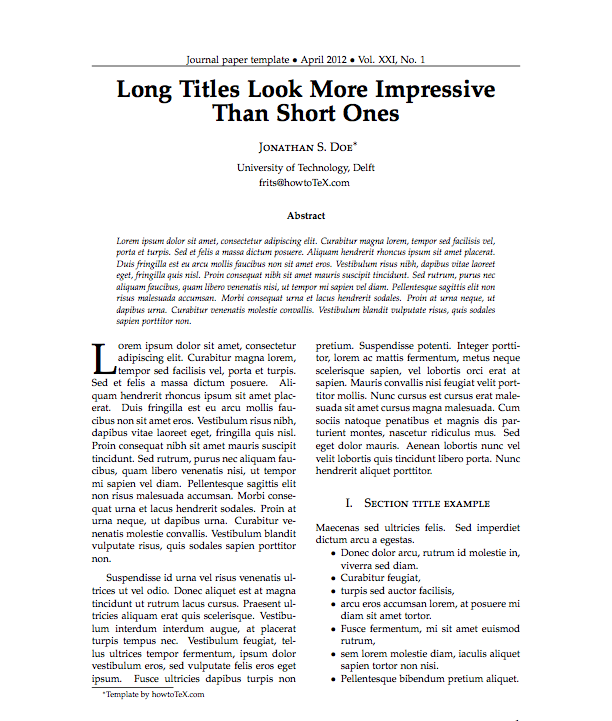Scientific Writing and Publishing for the Future
Sep 24, 2015

Challenges with tools for scientific writing
|
|
|
Scientific writing = LaTeX
- Pre 1980: handwriting + publisher
- Post 1985: scientists write LaTeX
- Post 2010: a few scientists explore new digital formats
\def\FrameCommand{\colorbox{shadecolor}}\FrameRule0.6pt
\MakeFramed {\FrameRestore}\vskip3mm}{\vskip0mm\endMakeFramed}
\providecommand{\shadedquoteBlue}{}
\renewenvironment{shadedquoteBlue}[1][]{
\bgroup\rmfamily\fboxsep=0mm\relax
\begin{shadedskip}
\list{}{\parsep=-2mm\parskip=0mm\topsep=0pt\leftmargin=2mm
\rightmargin=2\leftmargin\leftmargin=4pt\relax}
\relax}{\endlist\end{shadedskip}\egroup}\begin{shadedquoteBlue}
\fontsize{9pt}{9pt}
\begin{Verbatim}
print 'Hello, World!'
\end{Verbatim}
Big late 1990s question: Will MS Word replace LaTeX? It never did!
LaTeX PDF is mostly suboptimal for the new devices
|
|
|
The book will survive (LaTeX is ideal)

The classical report/paper will survive (LaTeX is ideal)
|
|
|
But there is an explosion of new platforms for digital learning systems!
MOOCs, Kahn Academy, ndla, H5P, Haiku Learning, Opigno, ...
|
|
|
My headache: How to write scientific material that can be easily published through old and new media?

LaTeX-for-paper and HTML-for-screen are two very different writing styles and technology platforms.
Scope: documents with much math and computer code
What tools should I use for scientific writing?
|
|
|
|
|
|
|
|
There is a jungle of outlets your scientific writings should address
|
|
Can I assemble lots of different writings to a new future document (book)?
Suppose I write various types of scientific material,
- LaTeX document,
- blog posts (HTML),
- web pages (HTML),
- Sphinx documents,
- IPython notebooks,
- wikis,
- Markdown files, ...
and later want to collect the pieces into a larger document, maybe some book - is that at all feasible?
Probably not, but I have a solution 
Pros and cons of various tools
Popular tools anno 2014 and their math support
- LaTeX: de facto standard for math-instensive documents
- pdfLaTeX, XeLaTeX, LuaLaTeX: takes over (figures in png, pdf) - use these!
- MS Word: too clicky math support and ugly fonts, but much used
- HTML with MathJax: "full" LaTeX math, but much tagging
- Sphinx: somewhat limited LaTeX math support, but great support for web design, and less tagged than HTML
- reStructuredText: similar to Sphinx, but no math support, transforms to lots of formats (LaTeX, HTML, XML, Word, OpenOffice, ...)
- Markdown: somewhat limited LaTeX math support, but minor tagging, transforms to lots of formats (LaTeX, HTML, XML, Word, OpenOffice, ...)
- IPython notebooks: Markdown code/math, combines Python code, interactivity, and visualization, but requires all code snippets to sync together
- Confluence: Markdown-like input, with limited LaTeX math support, but converted to XML
- MediaWiki: quite good LaTeX math support (cf. Wikipedia/Wikibooks)
- Other wiki formats: no math support, great for collaborative editing
- Wordpress: supports full HTML with LaTeX formulas only
- Google blogger: supports full HTML with MathJax
LaTeX is very rich; other tools support much less
- LaTeX has lots of fancy layouts, but few translates to other formats
- LaTeX inline math: works with all math-enabled formats (LaTeX, MathJax, Sphinx, Markdown, MediaWiki, Confluence, ...)
- LaTeX equation math:
- LaTeX:
equation*,equation,align*,align+eqnarray,split,alignat, ... (numerous!) - MathJax:
equation*,equation,align*,align - MediaWiki:
equation*,equation,align*,align - Sphinx:
equation*,equation,align* - Markdown:
equation*,equation,eqnarray*,align*(but no labels)
LaTeX is very rich; other tools support much less
- Figures: all
- Movies: raw HTML or YouTube/Vimeo, (LaTeX)
- Subfigures: LaTeX (
subfigure) - Floating computer code: LaTeX; fixed computer code: all
- Floating tables: LaTeX; fixed tables: all
- Algorithms: LaTeX
- Page references: LaTeX
- Cross references: LaTeX (also to external doc.)
- Equation references: LaTeX, HTML, Sphinx
LaTeX is very rich; other tools support much less
- Margin notes: LaTeX, HTML with tailored css code
- Footnotes: LaTeX, Sphinx, reStructuredText, MediaWiki
- Bibliography: LaTeX, Sphinx, reStructuredText, MediaWiki
- Index: LaTeX, Sphinx
- Hyperlinks: all (but not on paper!)
- Interactive programs: Sphinx, IPython notebook, raw HTML
- Searching in multi-page doc.: Sphinx, MediaWiki, LaTeX PDF
Highly non-trivial to translate from/to LaTeX!
My colleagues face fundamental problem with going from LaTeX to IPython notebook (=Markdown)
I am used to write LaTeX paper/book-style with lots of cross-references and floating figures, code snippets, tables, algorithms, but now I want to convert to IPython notebooks.
Must have fixed figures, code snippets, tables. No algorithm environment, cross-referencing, equation referencing. All code needed for a snippet to run must be included. It's a different writing style, but lots of new opportunities.
Examples on typesetting concerns (1)
- Sphinx refers to figures by the caption (has to be short!) and strips away any math notation (avoid that!).
- Sphinx refers to sections by the title, but removes math in the reference, so avoid math in headlines.
- Tables cannot be referred to by numbers and have to appear at fixed positions in the text.
- Computer code has to appear at fixed positions in the text.
- Algorithms must be written up using basic elements like lists or paragraphs with headings.
- Recipes are often typeset as enumerated lists. For recipes with code or math blocks: drop the list (gives problems in some formats) and use paragraph (or subsubsection) headings with "Step 1.", "Step 2.", etc.
Examples on typesetting concerns (2)
- Footnotes must appear as part of the running text (e.g., sentences surrounded by parenthesis), since only a few formats support footnotes.
- Sphinx does not handle code blocks where the first line is indented.
- Multiple plots in the same figure: mount the plots to one image
file and include this (
montagefor png, gif, jpeg;pdftk,pdfnup, andpdfcropfor PDF). - If you need several equations numbered in an
alignenvironment, recall that Sphinx, Markdown, and MediaWiki cannot handle this, although they have LaTeX math support. - Markdown tolerates labels in equations but cannot refer to them.
Examples on typesetting concerns (3)
- Index words can appear anywhere in LaTeX, but should be outside paragraphs in other tools.
- References to tables, program code and algorithms can only be made in LaTeX.
- Figures are floating in LaTeX, but fixed in other tools, so place figures exactly where they are needed the first time.
- Curve plots with color lines do not work well in black-and-white printing. Make sure plots makes sense in color and BW (e.g., by using colors and markers).
Solution I: Use a format that translates to many
- Sphinx can do nice HTML, LaTeX, epub, (almost) plain text, man pages, Gnome devhelp files, Qt help files, texinfo, JSON
- Markdown can do LaTeX, HTML, MS Word, OpenOffice, XML, reStructuredText, epub, DocBook, ... but not Sphinx
- IPython notebook: can do LaTeX, reStructuredText, HTML, PDF, Python script
- Sphinx and Markdown has some limited math support
Solution II: Use DocOnce
DocOnce offers minimalistic typing, great flexibility wrt format, especially for scientific writing with much math and code.
- Can generate LaTeX, HTML, Sphinx, Markdown, MediaWiki, Google wiki, Creole wiki, reST, plain text
- Made for large science books and small notes
- Targets paper and screen
- Many special features (code snippets from files, embedded movies, admonitions, modern LaTeX layouts, extended math support for Sphinx/Markdown, ...)
- Very effective for generating slides from ordinary text
- Applies Mako: DocOnce text is a program (!)
- Much like Markdown, less tagged than LaTeX, HTML, Sphinx
DocOnce: Write once, include anywhere

DocOnce demos
http://hplgit.github.com/teamods/writing_reports/
- LaTeX-based PDF for screen, for printing, for phone
- Plain HTML or Bootstrap or Bootswatch or with a template or another template or solarized
- Sphinx: agni, pyramid, classy, fenics, redcloud
- HTML for Google or Wordpress for blog posts
- MediaWiki (Wikipedia, Wikibooks, etc)
- DocOnce source code and tutorial
DocOnce disclaimer
- Based on text transformations (reg.exp.) so valid syntax may occasionally give problems
At any time one can divorce from DocOnce and marry one of the output formats, such as LaTeX or Sphinx. The generated code is clean.
DocOnce experience
- Code generation is a great thing
- Preprocessors a la Mako is a great thing
- Less tagging than LaTeX/HTML is a great thing
- Code generation software becomes a repository of advanced and nice constructs for layout
A tour of DocOnce
Title, authors, date, toc
TITLE: Some Title
AUTHOR: name1 at institution1, with more info & institution2
AUTHOR: name2 email:name2@web.com at institution
DATE: today
# A table of contents is optional:
TOC: on
Title and authors must have all information on a single line!
Abstract
__Abstract.__
Here goes the abstract...
Or:
__Summary.__
Here goes the summary...
Section headings
Headings are surrounded by = signs:
======= This is an H1/chapter heading =======
===== This is an H2/section heading =====
===== This is an H3/subsection heading =====
=== This is an H4/paragraph heading ===
__This is a paragraph heading.__
Result:
This is an H1/chapter heading
This is an H2/section heading
This is an H3/subsection heading
This is an H4/paragraph heading
This is a paragraph heading.
Markup and lists
* Bullet list items start with `*`
and may span several lines
* *Emphasized words* are possible
* _Boldface words_ are also possible
* color{red}{colored words} too
* `inline verbatim code` is featured
o and sublists with enumerated items starting with `o`
o items are just indented as you would do in email
This gets rendered as
- Bullet lists start with
*and may span several lines - Emphasized words are possible
- Boldface words are also possible
- colored words too
-
inline verbatim codeis featured - and sublists with enumerated items starting with
o - items are just indented as you would do in email
Labels, references, index items
# Insert index items in the source
idx{key word1} idx{key word2}
# Label
===== Some section =====
label{this:section}
# Make reference
As we saw in Section ref{this:section}, references, index
items and labels follow a syntax similar to LaTeX
but without backslashes.
# Make reference to equations
See (ref{eq1})-(ref{myeq}).
# Make hyperlink
"some link text": "https://github.com/hplgit/doconce"
# Hyperlink with complete URL as link text
URL: "https://github.com/hplgit/doconce"
Figures and movies
Figures with HTML and LaTeX size info, and caption: everything on one line
FIGURE: [figdir/myfig, width=300 frac=1.2] My caption. label{fig1}
Movies are also supported:
MOVIE: [http://youtu.be/IDeGDFZSYo8, width=420 height=315]
and rendered as
Math
Inline math as in LaTeX:
...where $a=\int_{\Omega}fdx$ is an integral.
gets rendered as ...where \( a=\int_{\Omega}fdx \) is an integral.
An equation environment is surrounded by !bt and !et tags,
the rest is plain LaTeX:
!bt
\begin{align}
\frac{\partial u}{\partial t} &= \nabla^2 u,
label{a:eq}\\
\nabla\cdot\pmb{v} & = 0
label{b:eq}
\end{align}
!et
which is rendered as
$$
\begin{align}
\frac{\partial u}{\partial t} &= \nabla^2 u,
\tag{1}\\
\nabla\cdot\pmb{v} & = 0
\tag{2}
\end{align}
$$
Math flexibility
Limit math environments to
\[ ... \]
\begin{equation*}
\end{equation*}
\begin{equation}
\end{equation}
\begin{align*}
\end{align*}
\begin{align}
\end{align}
- Sphinx, Markdown, and MediaWiki cannot have
alignwith labels - MathJax (HTML, Sphinx, Markdown, Mediawiki, ...) cannot handle equation references across web pages
Displaying code
Code is enclosed in !bc and !ec tags:
!bc pycod
def solver(I, a, T, dt, theta):
"""Solve u'=-a*u, u(0)=I, for t in (0,T] with steps of dt."""
dt = float(dt); N = int(round(T/dt)); T = N*dt
u = zeros(N+1); t = linspace(0, T, N+1)
u[0] = I
for n in range(0, N):
u[n+1] = (1 - (1-theta)*a*dt)/(1 + theta*dt*a)*u[n]
return u, t
!ec
This gets rendered as
def solver(I, a, T, dt, theta):
"""Solve u'=-a*u, u(0)=I, for t in (0,T] with steps of dt."""
dt = float(dt); N = int(round(T/dt)); T = N*dt
u = zeros(N+1); t = linspace(0, T, N+1)
u[0] = I
for n in range(0, N):
u[n+1] = (1 - (1-theta)*a*dt)/(1 + theta*dt*a)*u[n]
return u, t
Copying code from source files
We recommend to copy as much code as possible directly from the source files:
@@@CODE path/to/file
@@@CODE path/to/file fromto: start-regex@end-regex
For example, copying a code snippet starting with def solver( and
ending with (line not included) def next(x, y, is specified by
start and end regular expressions:
@@@CODE src/somefile.py fromto: def solver\(@def next\(x,\s*y,
Typesetting of code is implied by the file extension
-
.py:pyproif complete file,pycodif snippet -
.pyopt: visualized execution via the Online Python Tutor -
.f,.f90,f.95:fproandfcod -
.cpp,.cxx:cppproandcppcod -
.c:cproandccod -
.*sh:shproandshcod -
.m:mproandmcod -
ptex2tex: between 40+ code styles in LaTeX -
pygmentsis used for code in HTML (ca 10 styles)
Demonstrating code execution; Online Python Tutor
With !bc pyoptpro or a file *.pyopt, the code applies the
Online Python Tutor for displaying
program flow and state of variables:
Demonstrating code execution; Sage Cell Server
With !bc pyscpro or a file *.pysc, the code is typeset in
a sage cell:
Works only in Sphinx documents (but HTML support is possible).
Demonstrating code execution; IPython notebook
Can take a DocOnce source and transform to an IPython notebook with source
Tables
|--------------------------------|
|time | velocity | acceleration |
|---r-------r-----------r--------|
| 0.0 | 1.4186 | -5.01 |
| 2.0 | 1.376512 | 11.919 |
| 4.0 | 1.1E+1 | 14.717624 |
|--------------------------------|
Gets rendered as
| time | velocity | acceleration |
|---|---|---|
| 0.0 | 1.4186 | -5.01 |
| 2.0 | 1.376512 | 11.919 |
| 4.0 | 1.1E+1 | 14.717624 |
Newcommands for math
-
newcommands*.texfiles contain newcommands - Used directly in LaTeX
- Substitution made for many other formats
Labels, citations, index, bibliography
Lables, citations, index, and bibliography follow the ideas of LaTeX, but without backslashes:
===== My Section =====
label{sec:mysec}
idx{key equation} idx{$\u$ conservation}
We refer to Section ref{sec:yoursec} for background material on
the *key equation*. Here we focus on the extension
!bt
\begin{equation}
\Ddt{\u} = \mycommand{v} label{mysec:eq:Dudt}
\end{equation}
!et
Equation (ref{mysec:eq:Dudt}) is important, see
cite{Larsen_et_al_2002,Johnson_Friedman_2010a}.
Also, cite{Miller_2000} supports such a view.
Figure ref{mysec:fig:myfig} displays the features.
FIGURE: [fig/myfile, width=600] My figure. label{mysec:fig:myfig}
===== References =====
BIBFILE: papers.pub
The papers.pub file must be in Publish
format (easy to make from BibTeX).
Exercises
DocOnce offers a special format for exercises, problems, projects, and examples:
===== Problem: Flip a Coin =====
label{demo:ex:1}
files=flip_coin.py, flip_coin.pdf
solutions=mysol.txt, mysol_flip_coin.py
keywords = random numbers; Monte Carlo simulation
!bsubex
Make a program that simulates flipping a coin $N$ times.
!bhint
Use `r = random.random()` and define head as `r <= 0.5`.
!ehint
!esubex
!bsubex
Compute the probability of getting heads.
!bans
0.5.
!eans
!esubex
Rendering of the previous page
Problem 1: Flip a Coin
a) Make a program that simulates flipping a coin \( N \) times.
Hint.
Use r = random.random() and define head as r <= 0.5.
b) Compute the probability of getting heads.
Answer. 0.5.
Filenames: flip_coin.py, flip_coin.pdf.
Exercises
All exercises, problems, and projects in a document are parsed and available in a data structure (list of dicts) for further processing (e.g., making a book of problems).
[{'answer': '',
'closing_remarks': '',
'file': ['flip_coin.py', 'flip_coin.pdf'],
'hints': [],
'keywords': ['random numbers', 'Monte Carlo simulation'],
'label': 'demo:ex:1',
'solution_file': ['mysol.txt', 'mysol_flip_coin.py'],
'subex': [{'answer': '',
'file': None,
'hints': ['Use `r = random.random()` ...'],
'solution': '',
'text': 'Make a program that simulates ...'},],
'title': 'Flip a Coin',
'type': 'Problem'}]
Use of preprocessors
- Simple if-else tests a la the C/C++ preprocessor
-
FORMATvariable can be used to test on format, e.g., - if latex/pdflatex do one sort of code (raw LaTeX)
- if html, do another type of code (raw HTML)
- Easy to comment out large portions of text
- Easy to make different versions of the document
- The mako preprocessor is really powerful - gives a complete programming language inside the document!
DocOnce admonitions
Such environments may light up the document, but can be disturbing too. Some admon styles have icons.
More details can be separated from the rest.
Tasks:
- Maybe ask a question?
- Or two?
Conclusion:
- A special "block" admonition has less pronounced typesetting and can be used when no special icon is desired. Good for slides.
Generalized references
- Chapters can be stand-alone documents or parts of a book
- In a book you frequently refer to other chapters
- When a chapter is a stand-alone document, it must refer to another stand-alone chapter document
- This requires generalized cross-referencing
- LaTeX has a solution:
xr - DocOnce has a solution also for HTML, Sphinx, Markdown, ...
ref[internal][latex cite][external]
...as shown in ref[Section ref{sec:eqs}][ in cite{math_eqs_2020}][
the document "Mathematical Equations":
"http://some.net/doc/matheqs.html" cite{math_eqs_2020}].
Slides
Very effective way to generate slides from running text:
- Take a copy of your DocOnce prose
- Strip off as much text as possible
- Emphasize key points in bullet items
- Focus on key equations, figures, movies, key code snippets
- Insert
!splitwherever you want a new slide to begin - Insert
!bpopand!epoparound elements to pop up in sequence (or insert|\pause|inside code blocks) - Use 7
=or 5=in headings (H2 or H3) - Supported slide types: Beamer, HTML, HTML5 (reveal.js, deck.js, csss, dzslides)
Example on slide code
!split
===== Headline =====
* Key point 1
* Key point 2
* Key point 3: Although long
bullet points are not recommended in general, we need
it here for demonstration purposes to investigate
what happens with the slide layout where there is
so much text under one point
FIGURE: [fig/teacher1, width=100 frac=0.4]
Key equation:
!bt
\[ -\nabla^2 u = f \quad\hbox{in }\Omega \]
!et
And maybe a final comment?
!split
===== Next slide... =====
Example on slide code
Last page gets rendered to
Headline
- Key point 1
- Key point 2

Key equation:
$$ -\nabla^2 u = f \quad\hbox{in }\Omega $$
And maybe a final comment?
Grid layout of slide: MxN cells
Example with a bullet list to the left and a figure to the right (two cells: 00 and 01):
!split
===== Headline =====
!bslidecell 00
!bpop
* Key point 1
* Key point 2
* Key point 3
!epop
!bpop
!bt
\[ -\nabla^2 u = f \quad\hbox{in }\Omega \]
!et
!epop
!eslidecell
!bslidecell 01
FIGURE: [fig/broken_pen_and_paper, width=400 frac=0.8]
!eslidecell
!split
===== Next slide... =====
Grid layout of slide: MxN cells
Last page gets rendered to
Headline
|
|
Classic slide types
- LaTeX Beamer
- Plain HTML w/various styles
- separate slides w/navigation
- one big slide
HTML5 slide types
- Supported HTML5 packages:
- Problem: each package has its own syntax (though similar)
- Solution: slide code is autogenerated from DocOnce
- Problem: reveal and deck have numerous styles
- Solution: easy to autogenerate all styles for a talk
- Problem: HTML5 slides need many style files
- Solution: autocopy all files to talk directory
- Problem: original versions of the styles have too large fonts, centering, and other features not so suitable for lectures with much math and code
- Solution: DocOnce contains adjusted css files
DocOnce to HTML
Run in terminal window:
doconce format html doconcefile
# Solarized HTML style
doconce format html doconcefile --html_solarized
# Control pygments typesetting of code
doconce format html doconcefile --pygments_html_style=native
# Or use plain <pre> tag for code
doconce format html doconcefile --no_pygments_html
# Further making of slides
doconce slides_html doconcefile reveal --html_slide_theme=darkgray
Output for blog posts
Two formats of blog posts are supported:
- Google's blogspot.com: just paste the raw HTML (full support of math and code)
- Wordpress:
despite limited math, DocOnce manipulates the math
such that even
equationandalignwork in Wordpress :-)
For wordpress, add --wordpress:
doconce format html doconcefile --wordpress
and paste the code into the text area.
DocOnce to pdfLaTeX
doconce format pdflatex doconcefile --latex_code_style=lst
pdflatex doconcefile
bibtex doconcefile
pdflatex doconcefile
DocOnce to Sphinx
doconce format sphinx doconcefile
# Autocreate sphinx directory
doconce sphinx_dir theme=pyramid doconcefile
# Copy files and build HTML document
python automake-sphinx.py
google-chrome sphinx-rootdir/_build/html/index.html
Much easier than running the Sphinx tools manually!
Output for wiki
Only MediaWiki supports math.
doconce format mwiki doconcefile
Recommended site:
- ShoutWiki for standard wikis
Publishing of "official" documents:
DocOnce to other formats
doconce format pandoc doconcefile # (Pandoc extended) Markdown
doconce format gwiki doconcefile # Googlecode wiki
doconce format cwiki doconcefile # Creole wiki (Bitbucket)
doconce format rst doconcefile # reStructuredText
doconce format plain doconcefile # plain, untagged text for email
Installation
- Source at GitHub (recommended!)
-
git clone+sudo python setyp.py install - Many dependencies...
- Must have
preprocessandmako - Need
latex,sphinx,pandoc, etc. (see the Installation description) - Easy for slides: only
preprocessandmakoare needed :-)
Writing tips for LaTeX writers who want to convert to DocOnce and generate other formats
-
doconce latex2doconcehelps the translation - Use
\[ \],equation,equation*,align,align*and nothing more for equations - Figures: avoid subfigures (combine image files instead), use
\includegraphics, have captions after graphics, use short figure captions, position exactly where needed - Tables: have them inline (not floating), with no caption
- Computer codes: have them inline (not floating)
- Rewrite all
pagerefcommands - Do not use algorithm environments, use simple list formatting instead
- Avoid math in section headings
- Use
pdflatexorxetex - Use BibTeX (can easily be converted to publish used by DocOnce)
- Use
\hreffor links (and insert links frequently) - Use the
bmpackage for boldface \( \boldsymbol{u} \) - Place all newcommands in a separate file, with one definition per line (multiline definitions goes to a separate LaTeX preamble file in DocOnce)
- Avoid all fancy LaTeX constructs - more backslashes than needed in math and sections is a bad thing...
DocOnce writing tips
Figures and movies:
- Prepare figures in the right format: EPS for
latex, PDF forpdflatex, PNG, GIF or JPEG for HTML formats (html, and HTML output fromsphinx,rst,pandoc). One can omit the figure file extension anddoconcewill pick the most appropriate file for the given output format. - Let plotting programs produce both PDF/EPS and PNG files. (Recall that PDF and EPS are vector graphics formats that can scale to any size with much higher quality than PNG or other bitmap formats.)
- Use
doconce combine_imagesto combine several images into one. - Store all figures in a directory (tree) with name
figorfig-X, whereXis some short logical name for the current document. - Store all movies in a directory (tree) with name
movormov-X. - Favor the movie formats MP4, WebM, and Ogg (best suited for modern browsers).
DocOnce writing tips
-
\boldsymbol{u}gives nicer boldface typesetting of math symbols than the alternatives\boldsymbol{u}and\pmb{u}. - For HTML-based formats using MathJax,
\boldsymbol{u}is not supported and therefore automatically replaced by\boldsymbol{u}by DocOnce. - Use
\<font color="blue">formula</font>in math expressions to color a part. - Not all LaTeX math is supported by MathJax. Some legal LaTeX math might give MathJax problems - then one has to rewrite the expression to find a syntax that works both with LaTeX and MathJax.
- Use
doconce spellcheck *.do.txtto automatically spellcheck files. - Avoid page references and footnotes.
Writing tips for sphinx and other formats
For output formats different from latex, pdflatex, and html:
- Use labels only right after section headings and in equations.
- Be careful with labels in
alignmath environments:pandocandmwikicannot refer to them. -
sphinxoutput requires - no math in section headings or figure captions (gets removed in references).
- running text to start in column 1.
- progressive section headings: after chapter (9
=) comes section (7=), then subsection (5=), then paragraph (3=). Do not make jumps in this progression. - index entries (``) before the paragraph where they
are introduced and place them before subsubsection
headings (
=== ... ===) and after subsection and section headings. - a line of text and no comment or math before code or list.
















